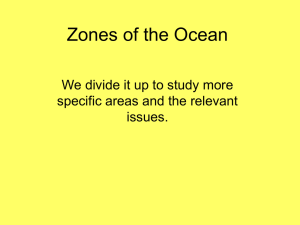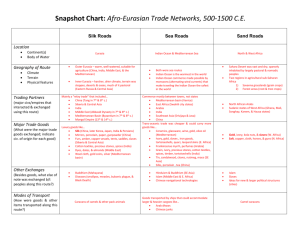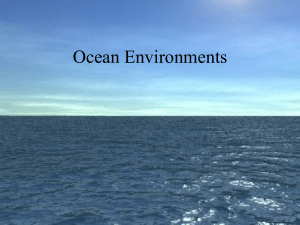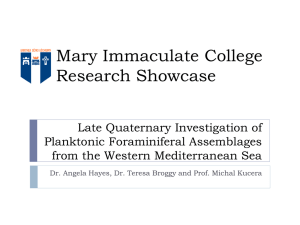jbi12669-sup-0001-AppendixS1-S2
advertisement
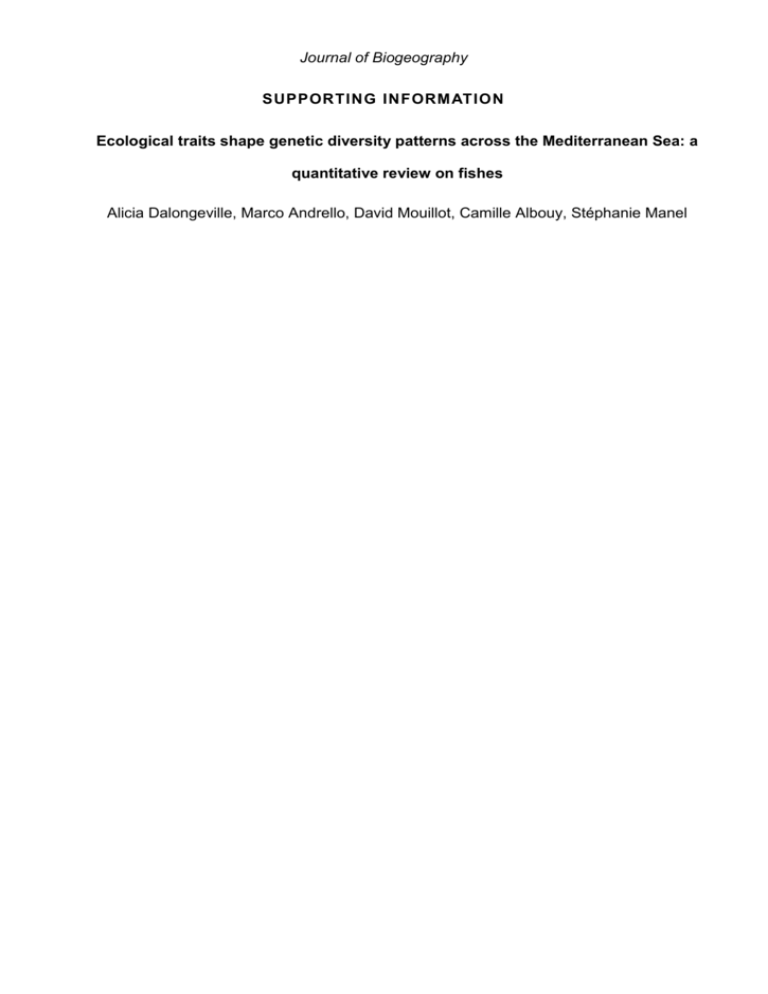
Journal of Biogeography SUPPORTING INFORMATION Ecological traits shape genetic diversity patterns across the Mediterranean Sea: a quantitative review on fishes Alicia Dalongeville, Marco Andrello, David Mouillot, Camille Albouy, Stéphanie Manel APPENDIX S1: Summary of the dataset used in the quantitative review: ecological traits and exploitation status of the sampled fish species, and number of populations sampled for expected heterozygosity (He) calculated with microsatellites markers and haplotype diversity (h) calculated with mtDNA. Species Aphanius fasciatus Family Vertical Exploited distribution Horizontal distribution Habitat Minimal Maximal depth depth (m) (m) Migration type Body Reproductive length strategy : (cm) Semelparity Sex shift # sampled locations References He h Cyprinodontinae No Demersal Littoral Posidonia 1 5 Amphidromous 6 Yes No - 38 (1–3) Gobiinae Yes Pelagic Continental Shelf Soft 5 100 Oceanodromous 3.75 Yes No - 5 (4) Atherina boyeri Atherinidae Yes Pelagic Littoral Soft, rocky, posidonia 1 3 Amphidromous 9 No No 11 12 (5,6) Atherina hepsetus Atherinidae Yes Pelagic Littoral Rocky 1 3 NA 15 No No - 11 (7) Chromis chromis Pomacentridae No Demersal Littoral Rocky & Posidonia 5 15 No 9 No No - 10 (8) Moronidae Yes Demersal Littoral Soft & Rocky 1 30 Oceanodromous 80 No No 23 9 (9–11) Sparidae Yes Benthic Littoral Rocky 1 40 Oceanodromous 25 No Protandrous 5 9 (12,13) Engraulis encrasicolus Engraulinae Yes Pelagic Littoral Soft 1 400 Oceanodromous 14 No No - 9 (14) Epinephelus marginatus Serranidae Yes Demersal Littoral Rocky 10 50 No 90 No Protogynous 16 8 (15–17) Gobius niger Gobiinae No Benthic Littoral Soft, rocky, posidonia 1 10 No 12.5 No No - 6 (4) Hippocampus hippocampus Syngnathidae No Benthic Littoral Soft 1 10 Amphidromous 10 No No - 5 (18) Lithognathus mormyrus Sparidae No Benthic Littoral Soft 5 50 NA 35 No Protandrous 6 4 (19) Lophius budegassa Lophiidae Yes Benthic Littoral & continetal shelf Soft & rocky 10 850 No 50 No No - 2 (20) Lophius piscatorius Lophiidae Yes Benthic All 10 1000 No 120 No No - 2 (20) Mugil cephalus Mugilidae Yes Pelagic Littoral 1 10 Catadromous 75 No No - 13 (21) Mullus barbatus Mullidae Yes Benthic Continental shelf and slope 30 300 NA 20 No No 14 5 (22,23) Aphia minuta Dicentrarchus labrax Diplodus sargus Soft & rocky Soft & Rocky Soft Mullus surmuletus Mullidae Yes Benthic Continental shelf and slope Soft 3 80 Oceanodromous 27.5 No No - 5 (22) Pomatoschistus minutus Gobiidae No Benthic Littoral Soft 1 20 No 7.5 Yes No 12 - (24) Sardina pilchardus Clupeidae Yes Pelagic Open ocean NA 5 60 Oceanodromous 19 No No 7 - (25) Scomber japonicus Scombrinae Yes Pelagic Open ocean NA 10 100 Oceanodromous 30 No No - 5 (26) Scomber scombrus Scombrinae Yes Pelagic Open ocean NA 1 100 Oceanodromous 35 No No - 4 (26) Serranus cabrilla Serranidae No Benthic Soft, rocky, posidonia 5 500 No 27.5 No Hermaphrodite 13 - (27) Solea vulgaris Soleidae Yes Benthic Soft 1 80 No 37.5 No No - 9 (28) Sparus aurata Sparidae Yes Demersal Littoral Soft, rocky, posidonia 10 30 No 55 No Protandrous 13 - (29,30) Syngnathidae No Benthic Littoral Soft & Posidonia 1 5 Amphidromous 12.5 No No - 8 (31) Thunnus thynnus Scombridae Yes Pelagic Open ocean NA 1 70 Oceanodromous 200 No No 21 - (32–34) Trachurus mediterraneus Carangidae Yes Pelagic Open ocean NA 10 50 Oceanodromous 30 No No - 9 (35,36) Trachurus picturatus Carangidae Yes Pelagic Open ocean NA 1 370 Oceanodromous 40 No No - 4 (35) Trachurus trachurus Carangidae Yes Pelagic Open ocean NA 10 100 Oceanodromous 30 No No 7 4 (35,37) Trisopterus minutus Gadidae Yes Demersal Continental shelf and slope Soft & Rocky 25 200 NA 27.5 No No 3 - (38) Xiphias gladius Xiphiidae Yes Pelagic Open ocean NA 10 125 Oceanodromous 250 No No - 5 (39) Syngnathus abaster Continental shelf and slope Continental shelf Total: 151 201 REFERENCES 1. Pappalardo A.M., Ferrito V., Messina A., Guarino F., Patarnello T., De Pinto V., & Tigano C. (2008) Genetic structure of the killifish Aphanius fasciatus, Nardo 1827 (Teleostei, Cyprinodontidae), results of mitochondrial DNA analysis. Journal of Fish Biology, 72, 1154–1173. 2. Ferrito V., Pappalardo A.M., Canapa A., Barucca M., Doadrio I., Olmo E., & Tigano C. (2013) Mitochondrial phylogeography of the killifish Aphanius fasciatus (Teleostei, Cyprinodontidae) reveals highly divergent Mediterranean populations. Marine Biology, 160, 3193–3208. 3. Triantafyllidis A., Leonardos I., Bista I., Kyriazis I.D., Stoumboudi M.T., Kappas I., Amat F., & Abatzopoulos T.J. (2007) Phylogeography and genetic structure of the Mediterranean killifish Aphanius fasciatus (Cyprinodontidae). Marine Biology, 152, 1159–1167. 4. Giovannotti M., La Mesa M., & Caputo V. (2009) Life style and genetic variation in teleosts: the case of pelagic (Aphia minuta) and benthic (Gobius niger) gobies (Perciformes: Gobiidae). Marine Biology, 156, 239–252. 5. Kraitsek S., Klossa-Kilia E., Papasotiropoulos V., Alahiotis S.N., & Kilias G. (2008) Genetic divergence among marine and lagoon Atherina boyeri populations in Greece using mtDNA analysis. Biochemical Genetics, 46, 781–798. 6. Milana V., Franchini P., Sola L., Angiulli E., & Rossi A.R. (2011) Genetic structure in lagoons: the effects of habitat discontinuity and low dispersal ability on populations of Atherina boyeri. Marine Biology, 159, 399–411. 7. Kraitsek S.N., Klossa‐Kilia E.A., Alahiotis S.N., & Kilias G.E. (2008) Genetic diversity of Atherina hepsetus (Osteichthyes: Atherinidae) populations as determined by RFLP analysis of three mtDNA regions. Journal of Natural History, 42, 649–659. 8. Domingues V.S., Bucciarelli G., Almada V.C., & Bernardi G. (2005) Historical colonization and demography of the Mediterranean damselfish, Chromis chromis: Chromis chromis speciation. Molecular Ecology, 14, 4051–4063. 9. Quéré N., Desmarais E., Tsigenopoulos C.S., Belkhir K., Bonhomme F., & Guinand B. (2012) Gene flow at major transitional areas in sea bass Dicentrarchus labrax and the possible emergence of a hybrid swarm. Ecology and Evolution, 2, 3061–3078. 10. Naciri M., Lemaire C., Borsa P., & Bonhomme F. (1999) Genetic study of the Atlantic/Mediterranean transition in sea bass (Dicentrarchus labrax). Journal of Heredity, 90, 591–596. 11. Lemaire C., Versini J.-J., & Bonhomme F. (2005) Maintenance of genetic differentiation across a transition zone in the sea: discordance between nuclear and cytoplasmic markers. Journal of Evolutionary Biology, 18, 70–80. 12. González-Wangüemert M., Cánovas F., Pérez-Ruzafa A., Marcos C., & Alexandrino P. (2010) Connectivity patterns inferred from the genetic structure of white seabream (Diplodus sargus). Journal of Experimental Marine Biology and Ecology, 383, 23–31. 13. González-Wangüemert M., Froufe E., Pérez-Ruzafa A., & Alexandrino P. (2011) Phylogeographical history of the white seabream Diplodus sargus (Sparidae): Implications for insularity. Marine Biology Research, 7, 250–260. 14. Magoulas A., Castilho R., Caetano S., Marcato S., & Patarnello T. (2006) Mitochondrial DNA reveals a mosaic pattern of phylogeographical structure in Atlantic and Mediterranean populations of anchovy (Engraulis encrasicolus). Molecular Phylogenetics and Evolution, 39, 734–746. 15. Maggio T., Andaloro F., & Arculeo M. (2006) Genetic population structure of Epinephelus marginatus (Pisces, Serranidae) revealed by two molecular markers. Italian Journal of Zoology, 73, 275–283. 16. De Innocentiis S., Sola L., Cataudella S., & Bentzen P. (2001) Allozyme and microsatellite loci provide discordant estimates of population differentiation in the endangered dusky grouper (Epinephelus marginatus) within the Mediterranean Sea. Molecular Ecology, 10, 2163–2175. 17. Schunter C., Carreras-Carbonell J., Planes S., Sala E., Ballesteros E., Zabala M., Harmelin J.-G., Harmelin-Vivien M., Macpherson E., & Pascual M. (2011b) Genetic connectivity patterns in an endangered species: the dusky grouper (Epinephelus marginatus). Journal of Experimental Marine Biology and Ecology, 401, 126–133. 18. Woodall L.C., Koldewey H.J., & Shaw P.W. (2011) Historical and contemporary population genetic connectivity of the European short-snouted seahorse Hippocampus hippocampus and implications for management. Journal of Fish Biology, 78, 1738– 1756. 19. Sala-Bozano M., Ketmaier V., & Mariani S. (2009) Contrasting signals from multiple markers illuminate population connectivity in a marine fish. Molecular Ecology, 18, 4811–4826. 20. Charrier G., Chenel T., Durand J.D., Girard M., Quiniou L., & Laroche J. (2006) Discrepancies in phylogeographical patterns of two European anglerfishes (Lophius budegassa and Lophius piscatorius). Molecular Phylogenetics and Evolution, 38, 742–754. 21. Durand J., Blel H., Shen K., Koutrakis E., & Guinand B. (2013) Population genetic structure of Mugil cephalus in the Mediterranean and Black Seas: a single mitochondrial clade and many nuclear barriers. Marine Ecology Progress Series, 474, 243–261. 22. Mamuris Z., Stamatis C., Moutou K.A., Apostolidis A.P., & Triantaphyllidis C. (2001) RFLP analysis of mitochondrial DNA to evaluate genetic variation in striped red mullet (Mullus surmuletus) and red mullet (Mullus barbatus) populations. Marine Biotechnology, 3, 264–274. 23. Maggio T., Brutto S.L., Garoia F., Tinti F., & Arculeo M. (2009) Microsatellite analysis of red mullet Mullus barbatus (Perciformes, Mullidae) reveals the isolation of the Adriatic Basin in the Mediterranean Sea. ICES Journal of Marine Science: Journal du Conseil, 66, 1883–1891. 24. Boissin E., Hoareau T.B., & Berrebi P. (2011) Effects of current and historic habitat fragmentation on the genetic structure of the sand goby Pomatoschistus minutus (Osteichthys, Gobiidae). Biological Journal of the Linnean Society, 102, 175–198. 25. Ruggeri P., Splendiani A., Bonanomi S., Arneri E., Cingolani N., Santojanni A., Colella S., Donato F., Giovannotti M., & Caputo Barucchi V. (2013) Searching for a stock structure in Sardina pilchardus from the Adriatic and Ionian seas using a microsatellite DNA-based approach. Scientia Marina, 77, 565–574. 26. Zardoya R., Castilho R., Grande C., Favre-Krey L., Caetano S., Marcato S., Krey G., & Patarnello T. (2004) Differential population structuring of two closely related fish species, the mackerel (Scomber scombrus) and the chub mackerel (Scomber japonicus), in the Mediterranean Sea: population structure of Mediterranean sea Scomber spp. Molecular Ecology, 13, 1785–1798. 27. Schunter C., Carreras-Carbonell J., Macpherson E., Tintoré J., Vidal-Vijande E., Pascual A., Guidetti P., & Pascual M. (2011a) Matching genetics with oceanography: directional gene flow in a Mediterranean fish species: effects of oceanography on Mediterranean Scomber. Molecular Ecology, 20, 5167–5181. 28. Guarnieo I., Franzellitti S., Ungaro N., Tommasini S., Piccinetti C., & Tinti F. (2002) Control region haplotype variation in the central Mediterranean common sole indicates geographical isolation and population structuring in Italian stocks. Journal of Fish Biology, 60, 1459–1474. 29. Šegvić-Bubić T., Lepen I., Trumbić Ž., Ljubković J., Sutlović D., Matić-Skoko S., Grubišić L., Glamuzina B., & Mladineo I. (2011) Population genetic structure of reared and wild gilthead sea bream (Sparus aurata) in the Adriatic Sea inferred with microsatellite loci. Aquaculture, 318, 309–315. 30. De Innocentiis S., Lesti A., Livi S., Rossi A.R., Crosetti D., & Sola L. (2004) Microsatellite markers reveal population structure in gilthead sea bream Sparus auratus from the Atlantic Ocean and Mediterranean Sea. Fisheries Science, 70, 852–859. 31. Sanna D., Biagi F., Alaya H.B., Maltagliati F., Addis A., Romero A., De Juan J., Quignard J.-P., Castelli A., Franzoi P., Torricelli P., Casu M., Carcupino M., & Francalacci P. (2013) Mitochondrial DNA variability of the pipefish Syngnathus abaster: genetic structure of Mediterranean S. abaster. Journal of Fish Biology, 82, 856–876. 32. Carlsson J., McDOWELL J.R., DíAz-Jaimes P., Carlsson J.E.L., Boles S.B., Gold J.R., & Graves J.E. (2004) Microsatellite and mitochondrial DNA analyses of Atlantic bluefin tuna (Thunnus thynnus thynnus) population structure in the Mediterranean Sea: population genetics of Mediterranean bluefin tuna. Molecular Ecology, 13, 3345– 3356. 33. Riccioni G., Landi M., Ferrara G., Milano I., Cariani A., Zane L., Sella M., Barbujani G., & Tinti F. (2010) Spatio-temporal population structuring and genetic diversity retention in depleted Atlantic Bluefin tuna of the Mediterranean Sea. Proceedings of the National Academy of Sciences, 107, 2102–2107. 34. Riccioni G., Stagioni M., Landi M., Ferrara G., Barbujani G., & Tinti F. (2013) Genetic Structure of Bluefin Tuna in the Mediterranean Sea Correlates with Environmental Variables. PLoS ONE, 8, e80105. 35. Karaiskou N., Triantafyllidis A., & Triantaphyllidis C. (2004) Shallow genetic structure of three species of the genus Trachurus in European waters. Marine Ecology Progress Series, 281, 193–205. 36. Turan B.C., Gurlek M., Yaglioglu D., & Ozturk B. (2009) Genetic differentiation of Mediterranean horse mackerel (Trachurus mediterraneus) populations as revealed by mtDNA PCR-RFLP analysis. Journal of Applied Ichthyology, 25, 142–147. 37. Kasapidis P. & Magoulas A. (2008) Development and application of microsatellite markers to address the population structure of the horse mackerel Trachurus trachurus. Fisheries Research, 89, 132–135. 38. Mattiangeli V., Ryan A.W., Galvin P., Mork J., & Cross T.F. (2003) Eastern and western poor cod (Trisopterus minutus capelanus) populations in the Mediterranean Sea: evidence from allozyme and minisatellite loci. Marine Ecology, 24, 247–258. 39. Viñas J., Pérez-Serra A., Vidal O., Bremer J.R.A., & Pla C. (2010) Genetic differentiation between eastern and western Mediterranean swordfish revealed by phylogeographic analysis of the mitochondrial DNA control region. ICES Journal of Marine Science: Journal du Conseil, 67, 1222–1229. APPENDIX S2 Definition of the different ecological traits used in the analysis. 1. 2. 3. 4. Vertical distribution Benthic: Species dwelling on, or relating to, the bottom of a body of water; living on the bottom of the ocean and feeding on benthic organisms (Froese & Pauly, 2015). Demersal: Species sinking to or lying on the bottom; living on or near the bottom and feeding on benthic organisms (Froese & Pauly, 2015). Pelagic: Species living and feeding in the open sea; associated with the surface or middle depths of a body of water; free swimming in the seas, oceans or open waters; not in association with the bottom. Many pelagic fish feed on plankton (Froese & Pauly, 2015). Horizontal distribution Littoral: Living in or related to near-shore waters; the intertidal zone of the marine environment, delimited by the tide marks of low and high water (Froese & Pauly, 2015). Continental shelf: The sea bottom from the shore out to a depth of 200m; a zone adjacent to a continent or around an island, and extending from the low-water line to the depth at which there is usually a marked increase of slope to greater depth; the edge of the continent that is submerged in relatively shallow ocean water (Froese & Pauly, 2015). Continental slope: Region of the outer edge of a continent between the generally shallow continental shelf and the deep ocean floor, from 200 to 2,000 m; often steep, slope-like (Froese & Pauly, 2015). Habitat Posidonia: Seagrass beds of Posidonia oceanica. Soft: consists of unconsolidated sediment (such as sand or clay) and unvegetated areas. Rocky: intertidal area of seacoasts where solid rock predominates (Lewis, 1964). Migration type Amphidroumous: Refers to fishes that regularly migrate between freshwater and the sea (in both directions), but not for the purpose of breeding, as in anadromous and catadromous species. Sub-division of diadromous (McDowall, 2010; Froese & Pauly, 2015). Anadromous: Fish that ascend rivers to spawn, as salmon and hilsa do. Sub-division of diadromous. Migrations should be cyclical and predictable and cover more than 100 km (McDowall, 2010; Froese & Pauly, 2015). Catadromous: Migrating from freshwater to the sea to spawn, e.g., European eels. Subdivision of diadromous. Migrations should be cyclical and predictable and cover more than 100 km (McDowall, 2010; Froese & Pauly, 2015). Oceanodromous: Migrating within oceans typically between spawning and different feeding areas, as tunas do. Migrations should be cyclical and predictable and cover more than 100 km (Froese & Pauly, 2015). 5. 6. Reproductive strategy Iteroparity: The reproductive strategy where individuals reproduce several times throughout their life (Froese & Pauly, 2015). Semelparity: The reproductive strategy where individuals reproduce once throughout their life (Froese & Pauly, 2015). Sex shift Protandrous: Sequential hermaphrodite in which the fish functions first as a male and then changes to a female (Froese & Pauly, 2015). Protogynous: Sequential hermaphrodite in which the fish functions first as a female and then changes to a male (Froese & Pauly, 2015). Hermaphrodite: Used as “synchronous hermaphrodite”: Having both sexes in the same individual at the same time (Froese & Pauly, 2015). REFERENCES Froese R. & Pauly D. (2015) Editors. FishBase. World Wide Web electronic publication, Version (02/2015). Lewis J.R. (1964) The Ecology of Rocky Shores. English Universities Press, London. McDowall R.M. (2010) Why be amphidromous: expatrial dispersal and the place of source and sink population dynamics? Reviews in Fish Biology and Fisheries, 20, 87–100.





